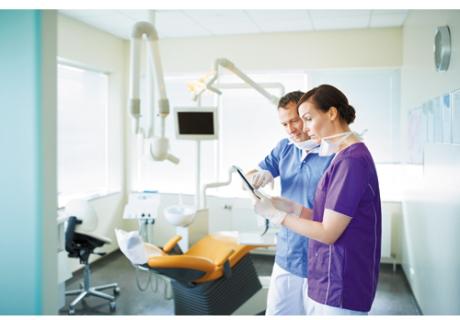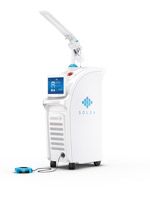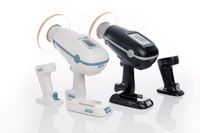If you had $10,000 to spend, what should you spend it on in your dental practice? Part 2 of 2
The same holds true for your dental practice, which is, don’t forget, a small business. You need to know every penny you spend in your practice is a worthwhile use of your funds. If not, your business could be in trouble.

We’re all looking for the smartest way to spend our money. We want to make sure that when we decide to purchase something, it’s really going to be the best thing on which we can possibly spend our hard-earned cash.
The same holds true for your dental practice, which is, don’t forget, a small business. You need to know every penny you spend in your practice is a worthwhile use of your funds. If not, your business could be in trouble.
With that in mind, we reached out to several of the nation’s leading dental consultants and dealer representatives and asked them one simple question: If a dentist had $10,000 to spend, what should he or she spend it on? We shared half of these responses in the August issue of Dental Products report, and now we bring you Part 2. From equipment to training and everything in between, read on to see what advice we were given on how you should spend your money.
Part 1: What $10,000 could do for your practice
Rachel Mele, consultant
If a dentist had just $10,000 to spend this year, I’d suggest they put those dollars towards a Solea laser.

As a mother to three children, I want what is best for my kids. My son, Joseph, who is 6, was recently diagnosed with six cavities. The dentist recommended six separate visits were Joseph would get Novocain or possibly anesthesia to fill his cavities. This protective mother was shocked. I may work in the dental industry but not on the clinical side. I want my children to avoid pain whenever it can be avoided. I also don’t want to pull them out of school more than I need to.
I did some research and learned about Solea lasers. I moved Joseph to a Solea practice where he had his cavities filled quickly and without Novocain or any pain whatsoever. Joseph was so excited about his visit to the dentist, he changed the home screen photo on my iPhone to a picture of him and his dentist (slightly awkward). Today, I tell all my mommy friends about Solea and have referred several of them to our new dentist. According to the American Dental Association Health Policy Institute, more children than ever are visiting the dentist (as opposed to adult visits, which are declining steadily). Solea laser practices have a unique opportunity to attract moms who want a better alternative for their children. A pain-free, drug-free option. From what I understand, $10,000 would cover about five monthly payments toward a Solea laser. By then, the dentist would see efficiency gains and new patient volume increases that would put him/her well ahead of the remaining monthly payments.
Related reading: The best dental products for your bucks
Denise Ciardello, consultant
It would be so easy to say $10,000 should go toward a new pretty piece of equipment-an iTero, CEREC or E4D-because that is what we SEE in the dental office. However, I would recommend looking in a different direction. Let’s take that $10,000 and spend it on the team.
As clinicians, dentists, dental hygienists and dental assistants are required to receive a set number of hours of continuing education every year or two, this is how I see these hours completed:
- The assistant scrambling through the internet at the 11th hour looking for an online course to complete.
- The dentist asking the office manager to check around to see if the local study clubs offer any CE meetings by August.
- The office closes for a day while the team attends the local dental conference. Team members attend courses that pertain to their area of the office
These fulfill the requirements for CE, but do they fulfill the needs of building a successful dental business?
More from this issue: How to ensure the entire team is on board with technology
Training is always a great place to start when looking to improve the production of a practice. Training helps ensure consistency throughout the office so every task is completed seamlessly. Efficiency is the focus for training.
Coaching brings it all together-letting the team truly understand the philosophy and vision of the doctor. When we have off-site workshops with the entire team, the light bulbs that go off, the oohs and ahs that are uttered and the long-term effect on the practice is much more valuable in building a successful dental practice than any pretty piece of new equipment.

My vote is to invest in some team time.
Dan Mulvey, equipment sales consultant,Henry Schein Dental
If a dentist had $10,000 to spend, I would recommend her or she invest it in solutions that would make the practice more efficient and more productive. Great examples are the NOMAD™ handheld dental X-ray systems and high speed electric handpieces.
Related reading: 5 technologies your practice needs to invest in now
D

r. David MoffetOverall, I think the best return on investment on $10,000 would come from spending money on your team. When you educate your team, you’re showing faith in it. Having your team members improve their knowledge and skills will make their job easier and more enjoyable. You will see an instant return on investment from that-far more than you would from spending it on updating your facility or marketing. You don’t want patients thinking you make too much money and spend it all on your office.
From an equipment standpoint, my advice would be to invest the $10,000 on intraoral cameras and big screen monitors. Having an intraoral camera hooked up to a large monitor in your operatory will definitely help with case presentation and acceptance and give you a significant return on that investment. When a tooth appears on your monitor and it’s the same size as a football, the patient can easily see what you are talking about. It will dramatically improve case acceptance.
Related reading: A change whose time has clearly come: Implementing new technology
Bob Spiel, consultant
What would I suggest a dentist spend $10,000 on? Take your team on a ropes course with an expert facilitator. Let’s face it, every practice has a culture … and most of them are by default. Working together in a situation like this helps a team become more trusting, more understanding and even more real with each other, and that will translate over into the day-to-day work long after the ropes course is over.
When people are real and honest with each other, that’s when the magic happens inside a practice. Having this kind of attitude every day can move an office culture forward by years and be not just a practice changer but a life changer, as well.
Naomi Cooper, consultant
If a dentist has $10,000 to spend on the practice, regardless if it’s a new practice, a mature practice or one nearing transition, I would undoubtedly recommend the money be spent on branding and website design. Here’s why.
These two elements will ensure the practice’s visibility within the local community and put it on a path to sustainable practice growth. There’s no growth without new patients, and it’s nearly impossible to attract new patients without a branding strategy and modern website.
More from Naomi Cooper: Top tips for designing a modern dental practice website

Your brand is essentially the identity of your practice. Who are you? What do you offer patients? Your brand (including the practice name and professionally designed logo) communicates why patients should choose you over the competition and provides a consistent message across all media-from print to online. Remember it takes an average of seven times for a message to get through to patients so it’s important that your message is consistent.
And while word of mouth is the most powerful form of marketing, patients today will still search for you online before contacting the practice. In fact, patients are 10 times more likely to find you online than in the YellowPages. Your website needs to be easy to find and easy to navigate. The three biggest mistakes I see with dental practice websites are:
1. The branding and logo aren’t used throughout the website and are not consistent with printed materials.
2. Logo, practice address and phone number are not clearly displayed above the fold on the homepage.
3. The site isn’t optimized for mobile. To check if your website is mobile-ready, Google provides an objective measurement of whether it views your website as optimized for mobile or not: google.com/webmasters/tools/mobile-friendly.
More from Naomi Cooper: 7 tips for using social media to reach patients of all ages
Plan to hire graphic and website designers with proven experience in the dental industry to get these two key areas done right the first time. When complete, a dentist can be confident knowing he or she has established a solid foundation for practice growth, and that’s money well-spent!
Kimberly Franek, consultant
If a dentist had $10,000 to spend on his or her office, I would recommend he or she update all visual areas for the patients. Patients have many choices in which dentist they see, and, most importantly, they have the choice on whether they refer friends and neighbors to their dentist. I have found that with the following changes, the average dentist’s positive reviews on social media go up as well as his or her referral and new patient numbers.
The first thing to start with would be a logo. This will form your practice brand and image from the style to the colors. I suggest logotournament.com. You place an amount you are willing to spend, I suggest $300, and have designers all over the world create a logo just for you. Once you have the logo, you can update your front-door and street signage for about $1,000. Then I suggest painting inside in all public areas for around $2,500. Now you are ready for updated waiting room furniture from target.com for a budget of $2,500. Make sure the look and colors reflect your logo and wall colors. You want everything to represent your image and brand. You can order updated business cards with appointment cards on the back from vistaprint.com for $150. For a new website, I recommend productivedentist.com. It has a Forever Site that includes full custom website design in which you own all of the content, and it sets up all social media accounts and does monthly blogging and updates to the social media sites for $825 month. This monthly fee is much easier to swallow for a dentist on a budget then the huge up-front cost many companies charge. Now for team uniforms that match the logo and look of the office. Based on seven team members, it should be about $1,850 from http://uniformadvantage.com and landsend.com. I like having the business team in business attire rather than scrubs for a more professional appearance.
Related reading: How to design the dental practice of your dreams
New patient welcome gifts are a great addition to any office. Candles from Walmart and logo-printed stickers for the candles, craft bags and tissue paper can be purchased from bagsandbowsonline.com for $500. You always want your office to feel and smell like home so a candle for the check-in area from circleecandles.com in the Country Morning Scent for $30 is a great addition to achieve that goal. Update your magazine subscriptions for the waiting room from ebscomags.com- I recommend not getting magazines about travel, RVs or automobiles. This will lend a patient to think about ways to spend a bonus or savings when they may need a large treatment plan in your office or be a candidate for an elective procedure. These subscriptions will cost about $200. You never get a second chance to make a first impression so go to your local big box retailer and purchase a nice new doormat and two potted plants for the front door. Also go to Target and get a wreath for the front door. Make sure your plants always stay watered and the front porch is always swept off and neat. This should cost no more than $145. When this is all completed, you and your team will have a rejuvenated space ,and your patients will thank you for it. You will be impressed by the accelerated level of professionalism your team will portray as well.
Dr. Roy Shelburne
What should a dentist spend $10,000 on? It’s a great question and my answer is nothing without first identifying the greatest area of pain in the practice.
Related reading: Key statistics and best trends in dental practice management: 2012 to 2014
Dentistry is in a state of unprecedented flux. I’ve been in the dental world since my first day in dental school 38 years ago. I can honestly say, without question, the landscape is changing more rapidly today than ever before in our history. Because things are changing so rapidly and on so many fronts, I don’t believe anyone could or should suggest there’s one magic product, service or procedure that will yield the highest and best result for all doctors, practices and teams in all situations. Making the inference that one investment fits all is foolhardy, at best, and a total waste of the $10,000, at worst.
No two practices are the same. Because of this differentiation, what could be beneficial for one practice would be worthless in another. I would suggest the doctor and team identify the area of greatest pain, that is, the greatest area of need, and determine how to address that need. For example, if that need/concern/opportunity to improve the practice lies in increasing reimbursement (coincidentally, my passion), I would suggest that practice begin tracking the numbers associated with its reimbursement. Those numbers could include number of claims rejections, number of denials and number of requests for additional information. If claims are consistently delayed or denied, some of the $10,000 could be used to train existing staff on insurance coding and administration, provide the needed reference and training materials or hire consultant to provide the customized assessment, training and support.
I would suggest the $10,000 be invested in improving a system that will alleviate or reduce the greatest point of pain in that individual practice.
DentalCodeology: CDT 2015 shifts and dental coding tips every practice should know
Hollie Bryant, consultant
Oftentimes, dentists make investments on education and equipment without a plan in place for ROI. In many cases, these investments do not pay off and collect dust in the practice, whether that be literally or metaphorically. When determining any type of investment with a client, I always ask one simple question: How do you see this making money for your business?” Business decisions are recommended to be a win for the team, patient care and the business itself. If one isn’t going to reap the ROI, then you have to understand that before taking the leap on the investment. Going into a decision with expectations on paper and your strategic plan of implementation in place are the greatest gifts you can give yourself.
When considering the digital age of dentistry we live in and thinking back to how many offices are still operating with the bare minimum of anything digital, I would be very skeptical to recommend any type of continuing education courses knowing there would be a huge chance they would never be a return on the investment.
The one tool missing in many practices that is a must-have in today’s dental practice would be an intraoral camera for each clinical treatment room. Intraoral cameras have evolved tremendously and now compete with digital SLR cameras in many dental practices. They have the ability to zoom in and out, which satisfies taking a full-arch, quadrant or single-tooth shot, (every doctor has his or her own custom needs when looking at photos with patients). The cost of an intraoral camera in today’s market is pennies compared to a decade ago. You could supply a six-treatment room office with cameras for less than $4,000. There are many bells and whistles that can be exchanged when selecting a camera for the office. This will allow you the additional funds to purchase a few laptops or tablets that could operate the cameras.
Related reading: The top advances in caries detection
I have had clients purchase cameras on Amazon for $123, and they work great (the downfall is the you have to save the image from the keyboard.). You can only freeze with the camera (Who cares if the camera breaks? You buy a new one.). These cameras obviously do not have a zoom feature. Watchmouth.com is a company that sells a six-pack of cameras for less than $1,200, and they work with an app that interacts with patients. Both of these cameras integrate with the common dental software on the market. We know the bells and whistles add to the investment, and all the leading digital imaging companies have something to offer, but you will still be able to keep a six-treatment room office supplied with cameras for under $10,000 and have a ½ of day of team training expenses to boot the initial start up and implementation for these cameras. “ A picture is worth a thousand words,” or, in the world of dentistry, “a picture is worth a thousand dollars.”
The ROI on digital images is a definite win-win for a dental practice. Patients will understand what they see, and team members will be able to convert dental problems into dental treatment. The business will re-ignite and thrive again.
There should be no reason we are not using digital images as a standard of care in a dental practice these days. With the amount of issues on the rise with customer complaints and doctors’ reputations, it is imperative to document every level of care. (Why can’t we pick up good habits from our orthodontic community? They have been documenting at every stage for decades.)
So why not do your business a favor and document better while making more money. It’s definitely a good business investment.
More on digital images: How digital dentistry works